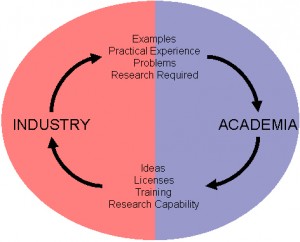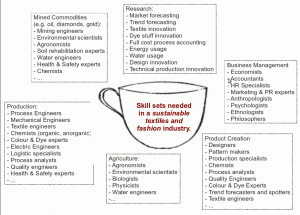
Recently I read the following cynic joke in a newspaper, in the run up to the Durban climate summit:
Two planets meet on the Milky Way. Says the first to the second: 'What's the matter? You've got a fever?' Answers the second: 'It's awful really, I've got homo sapiens, and I don't know what to do any more. No matter what it's getting worse and worse...'. Answers the first: 'Don't worry, I had that too, it won't last very long. It's a self-neutralising disease. A little patiences, and you'll be just like new.'
Shocked? Inappropriate to ridicule the current sustainability crises in this way?
Of course it is, but that’s precisely the point.
Let’s be honest. The name of the global sustainability game – hence also in fashion and textiles – has in reality a very ego-centric title: ‘Survival of our own species’. Or to turn this into a somewhat more drastic formulation: ‘How can we guarantee the human species to survive on a planet with limited resources, but a human race that seemingly has an insatiable thirst for exactly these?
And you read right, it’s not about ‘saving the planet’ – the planet is doing just fine, and will survive with or without us, thank you very much.
Our cause is self-interest. No functioning eco-system, no homo sapiens. It’s that simple.
The problem is though: We have by far underestimated the damage we’ve caused to our habitat up to this point. The challenge is so huge that its complexity is without a doubt beyond what businesses know how to deal with, or academics know how to beautifully chop up into bits and pieces waiting to be analysed and understood. Industry, commercial business and academia have a love-hate relationship.
Yet, neither academics, nor businesses, designers nor creators are ready to throw their inter- and trans- disciplinary clichés overboard and just sit around the virtual round table ‘to make it happen’.
This is nothing new, and for any of us who as seen both sides of the coin, it can’t but described as a veritable pain. In fact, in many cases this would be even irresponsible on a personal (as in: individual) level. And this is why:
Academics tend to think in segregated disciplines and publication lists. Publication lists are the equivalent of performance appraisals in the industry, and the goal is to score as high as possible which requires a high degree of specialisation. High-rated publications are for academia an essential ingredient to guarantee a job, which in return means personal safety, the luxury of owning a house, raising a family and taking holidays once a year. And who would be irresponsible enough to sacrifice this, and instead turn the academic world upside down by ignoring these ‘performance appraisals’.The problem is that this approach is little helpful when dealing with the ‘messy real world’. And there isn’t much that can get much messier than the whole sustainability discussion.
Now, industry and business on the flip side assume that just because they find themselves in the ‘messy real world’, that all academic insights mean little for them, and hence they do not have anything to learn from or discuss with academics. They’re focus is to generate money for their shareholders and some of their stakeholders (staff, suppliers). Again, for the sake of their house, their family and their holidays – why would they do otherwise? Them, too, have an interest in surviving (well) as an individual.
The troubling part for me is that both groups, plus the so far unmentioned third party which would be designers and creators, still can get away with this attitude. There are still no incentives for real innovation, for ‘doing stuff differently’. ‘Allotment attitudes’ (or ‘not in my backyard attitudes’) are just wrong in any way imaginable.
But – what does this have to do with changing the fashion industry?
To make it concrete: Doing what I have done – plunging into this discipline (‘ethical’ fashion’) convinced that ‘out of the box’ thinking will move things ahead – is, metaphorically speaking, existential suicide. It’s swimming against the stream, against a majority that believes to know better, it means being face to face with people who have spent decades doing stuff ‘their way’. It also means not being taking seriously in more that a single instance for the simply reasons of having an educational background that doesn’t fit into the traditional schema of mental drawers that proliferates. Expertise and capabilities only count after a life time. Because, despite its public perception, the industry is much more conservative than most of what I have encountered up to this point. Both, in academics as well as business.
Needless to say that it’s only worth it if one is really, really, passionate and serious about it.

This industry is in dire need for collaboration, for making away with historic clichés and hierarchies of ‘master and servant disciplines’. We have problems to solve, massive problems. There’s no other way to solve these than to sing from the same hymn sheet.
It also happens that the fashion and textiles industry is probably one of the most trans-disciplinary industry overall I can think of. From agriculture and oil, to mechanical engineering, organic and anorganic chemistry, logistics, biology, marketing, even ethnology and sociology can be tied to it.
Fashion and textiles are also the 2nd most largest industry as far as its impact on the planet is concerned. So far the latter has been but negative, but imagine the potential, and what would be feasible if all that influence were used to change things around …!

